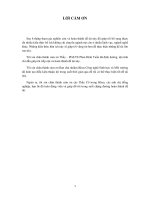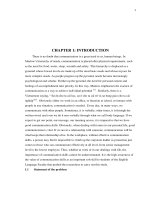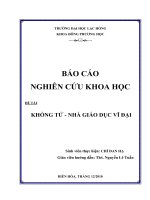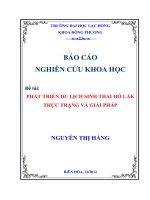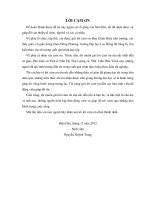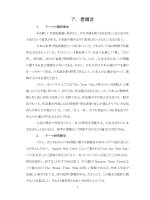Báo cáo nghiên cứu khoa học " Livestock Research Priorities 2008-2012 " doc
Bạn đang xem bản rút gọn của tài liệu. Xem và tải ngay bản đầy đủ của tài liệu tại đây (161.09 KB, 15 trang )
Collaboration for Agriculture and Rural Development (CARD) Program
Ministry of Agriculture &
Rural Development
Livestock Research Priorities 2008-2012
Priority Setting Workshop
Hanoi
December 2007
Livestock Research and Development Priorities i
TABLE OF CONTENTS
1 Introduction 1
2 Methodology 2
2.1 Objectives 2
2.2 Research Priority Framework 2
2.3 Pre-Workshop Preparation 3
2.3.1 Organisation and Planning 3
2.3.2 Training in Priority Setting Methodology 3
2.3.3 Areas of Research Opportunity 3
2.3.4 Data & Evaluation Sheets and Workshop Instructions 4
2.4 Workshop Format 4
2.4.1 Workshop Venues and Format 4
2.4.2 Workshop Chairpersons and Group Facilitators 4
2.4.3 Workshop Process 4
3 Workshop Results 5
3.1 Return on Investment 5
3.1.1 Comment 6
3.2 Attractiveness 7
3.2.1 Comment 7
3.3 Feasibility 8
3.3.1 Comment 9
4 Priorities within ARDOs 10
5 Investment Portfolio 12
6 The Next Steps 12
Attachments
1. Livestock Sub-sector Priority Setting Workbook
2. Livestock Sub-sector Priority Setting Data and Information Sheets
Livestock Research and Development Priorities 1
1 Introduction
The Government of Vietnam’s Socio-Economic Plan outlines the government’s
expectations for agriculture and rural development. In 2007 MARD outlined the targets
for livestock production. By 2010 pig numbers are expected to be 35-40 million, buffalo
2.8-3.0 million, beef cattle 6.5 million, with 200,000 dairy cows producing 300,000
tonnes of fresh milk. In addition the target for poultry is 380-390 million head. These
targets suggest growth in production in the livestock sector of 12-15% per annum,
compared with a projected growth in agriculture as a whole of 3-5%.
Vietnam is a net importer of livestock products and as per capita income increases it is
expected that the demand for livestock products, particularly red meat and milk will
continue to outstrip local capacity to supply. Major structural change in the livestock
sector has been slow, but particularly in the pig and poultry sectors the development of
intensive, larger scale commercial production is now occurring. This structural change is
likely to quicken with a requirement for significantly increased capital investment.
Research in livestock production has traditionally focused on small-scale production
systems but in recent years research has contributed to the development of larger scale
intensive production systems. For large animals, the capacity to provide sufficient
adequate quality feed is a major limiting factor in increasing production and expansion of
the beef and milk production industries will depend on improved use of residues from
crop production, development of cost effective feed supplements and additives and
introduction and expansion of new and improved forages. For smaller animals, pigs and
poultry the development of intensive breeding, rearing and finishing systems is also
necessary. The ability of Vietnam to compete with lower priced, higher quality imported
livestock products is low and unless this can be significantly improved the cost to
Vietnam for importation of livestock products will continue to increase. Above all
Vietnam is vulnerable to outbreaks of infectious diseases which can cause catastrophic
losses in the livestock sector and can pose a threat to human health. Development of new
and improved disease prevention and control mechanisms will be critical to achievement
of production targets.
The opportunities for research to contribute to continued expansion in the contribution of
the livestock sector to the national GDP have increased and the research issues have
become more complex. However there is limit to the research resources (human,
financial and infrastructure) that can be directed towards delivery of benefits from
research. Because of the limit on resources it is necessary for the livestock research
community to be selective in investing those resources in priority research programs that
are most likely to provide the highest return on investment. A key policy question is
what research to invest in. The development of a research priority framework and
research investment portfolio is the first step of a research strategy that will lead to
improved relevance and impact of research. Research priority setting is therefore an
important step in the research resource allocation process. Methodologies for priority
setting have been adapted for use in Vietnam in conjunction with the AusAID funded
Collaboration for Agriculture and Rural Development (CARD) Program.
Livestock Research and Development Priorities 2
This report details the methodology and results obtained from the Livestock Research
Priority Workshop held in Hanoi on December 12
th
2007. The research priorities
determined at this workshop is the first step in identification of priority research
programs and the determination of a research investment portfolio. Once this task is
complete MARD will prepare and publish its Medium-Term Livestock Research Plan.
2 Methodology
2.1 Objectives
To demonstrate an appropriate priority setting methodology suitable for future use
by MARD.
To determine the priorities for investment in Areas of Research and Development
Opportunity (ARDOs) for the Livestock Sub-sector
To determine the relative priority of livestock crops/species/products within
ARDOs
To outline the next steps in development of research strategies for high priority
research programs and the development of a Medium-Term Research Plan.
2.2 Research Priority Framework
Priority analysis is based on a criterion based analytical framework
1
, which has been
adapted to conditions in different developing countries. The conceptual framework is
shown in Figure 1.
Figure 1 Research Priority Framework
1
Foster, R.N., Linden, L.H., Whiteley, R.L., and Kantrow, A.M., Improving the Return on R & D, in
‘Measuring and Improving the Performance and Return on R & D’ IRI, New York (originally published in
Research Management January 1985.
Livestock Research and Development Priorities 3
The Methodology was detailed in a Workshop Workbook (Attachment 1) supported by
ARDO Data and Information Sheets (Attachment 2).
The workshop aim was to create ownership through developing a consensus between
users and providers of research for the research priorities. Sixty stakeholders,
representing researchers and research managers, extension workers, universities and the
private sector enterprise and researchers participated in the workshop.
The workshop process required individual participants to score each Area of Research &
Development Opportunity (ARDO) for each of the 4 criteria (Potential Benefits, Ability
(or constraints) to Capture Benefits, Research Potential and Research Capacity) before
they attended the workshop. Working groups, facilitated by trained and MARD staff
discussed the reasons behind individual priority scores and each participant was invited to
rescore if they desired. Individual Scoring Sheets were collected and entered in an
EXCEL Spreadsheet.
Within each of the ARDOs the livestock crops/species/products that made up the ARDOs
were also prioritised as a first step towards the development of multi-disciplinary priority
research programmes.
2.3 Pre-Workshop Preparation
2.3.1 Organisation and Planning
MARD established a Research and Development Priority Setting Working Group (WG)
to assist in the development of methodologies and processes that could be applied across
all sub-sectors of the Primary Sector (Agriculture, Forestry, Fisheries and Livestock).
The WG’s task was to provide the authority and direction for establishment of
agricultural research priorities. A workshop outlining the priority setting process was
presented to the WG and individual WG members undertook to promote the process and
facilitate and chair priority setting workshops.
2.3.2 Training in Priority Setting Methodology
MARD established a Monitoring and Evaluation Network (M&EN). The M&EN
consisted of staff from the Department of Science and Technology (DST) and staff from
research institutes with responsibility for monitoring and evaluation. Two workshops
were completed with the M&EN and at the conclusion of these workshops 12 M&EN
members had demonstrated their understanding of the methodology. M&EN members
facilitated priority setting planning workshops and provided group facilitation services at
national priority setting workshops.
2.3.3 Areas of Research Opportunity
A workshop of key research staff from Livestock and Veterinary Research Institutions
participated in a preliminary workshop designed to reach agreement on Livestock
ARDOs.
Livestock Research and Development Priorities 4
Seven ARDOs were defined. The format for each ARDO of the Data and Evaluation
Sheets was outlined. Key staff from Research Institutions with a broad knowledge of the
livestock industry and specialist technical expertise were identified and appointed as
ARDO Leaders. The ARDO Leaders took responsibility for preparing draft Data and
Evaluation Sheets.
The Seven ARDOS were:
ARDO 1: Large Animals
ARDO 2: Small Ruminant Animals
ARDO 3: Pig Production
ARDO 4: Poultry
ARDO 5: Productive Insects
ARDO 6: Veterinary Vaccines & Animal Remedies
ARDO 7: Animal Feed Processing & Conservation
2.3.4 Data & Evaluation Sheets and Workshop Instructions
Draft Data and Evaluation Sheets were prepared and the PMU critiqued and edited them
to ensure that critical information was supplied and all data and evaluation sheets had a
similar format and content. Data and Evaluation Sheets for each of the 7 ARDOs were
prepared as a separate publication (Attachments 1 and 2) and distributed to invitees prior
to the workshop. The methodology was outlined and each workshop participant was
asked to read all workshop material and make a preliminary score for each of the four
evaluation criteria.
2.4 Workshop Format
2.4.1 Workshop Venues and Format
One workshop was facilitated at the La Thanh Hotel Hanoi on December 12
th
2007.
2.4.2 Workshop Chairpersons and Group Facilitators
Mr Hoang Kim Giao, (Department of Livestock Production and Mr Le Van Bam,
(Department of Science & Technology) took dual responsibility for chairing the Priority
Setting Workshop.
Members of the M&EN and additional Fisheries research institute staff met with the
CARD Technical coordinator prior to each workshop to outline the process of facilitation
of work tables during the priority setting workshop. Workgroup Facilitators were:
Mr. Vu Chi Cuong, National Institute of Animal Husbandry
Mr. Phạm Sy Tiep, National Institute of Animal Husbandry
Mr. Tong Xuan Chinh, Department of Livestock Production
Mr. Trịnh Phu Ngọc, Veterinary Institute
Mr. Nguyen Viet Hai, Department of Science & Technology
2.4.3 Workshop Process
The workshop followed the following steps:
Livestock Research and Development Priorities 5
1. Workshop format and process outlined, including a brief description of the
methodology and an outline of the priority framework
2. Detailed description of the Potential Benefit evaluation criteria including the key
assessment issues
3. Preliminary scoring for Potential Benefits for each ARDO by each workshop
participant
4. Work table discussion on reasons for high and low scores for Potential Benefits
and reassessment of preliminary scores by each participant
5. Collection of individual scoring sheets and entry of individual scores for Potential
Benefit for each ARDO.
6. Repetition of steps 2 – 5 for each of the remaining evaluation criteria (Ability to
Capture, Research Potential and Research Capacity
7. Formation of specialist groups for each ARDO and prioritisation of crops/outputs
within each ARDO
8. Presentation of workshop results to participants
9. Outline of Next Critical Steps in the development of research priorities
3 Workshop Results
3.1 Return on Investment
Return on investment is the product of attractiveness and feasibility. The relative return
on investment in each area of research opportunity is summarised below
28
Workshop Output – Return on
Investment
7. Animal Feed Processing
& Conservation
6. Veterinary Vaccines &
Animal Remedies
5. Productive Insects
4. Poultry
3. Pig Production
2. Small Ruminant Animals
1. Large Animals
RET URN FROM INVEST MENT IN EACH AREA
OF RESEARCH OPPORTUNIT Y
7
6
5
4
3
2
1
0
10
20
30
0 10 20 30
Feasibility
Attractive-
ness
Livestock Research and Development Priorities 6
3.1.1 Comment
The main points arising from the workshop’s Return on Investment assessment are:
Highest Return on Investment
ARDO 6 (Veterinary Vaccines and Animal Remedies) was assessed as having the
highest return for investment in research. The high return on investment is
expected because of a high potential for research to contribute to improved
productivity of the livestock sector. Return on investment could be increased
even further if Attractiveness, which was relatively low due to a perceived low
Likelihood of Uptake and improved capacity in this ARDO, could be achieved.
High returns on investment in research in this ARDO are no doubt due to the high
risk in Vietnam of large numbers of deaths from infectious diseases and the high
impact of clinical and sub-clinical diseases on animal productivity.
The overall Return on Investment for research into pigs and poultry was similar
and only slightly lower than ARDO 6. The main reason for relatively high return
on investment is the size of the pig and poultry industries and the potential for
improved productivity as restructuring occurs in both industries with a move
towards larger, intensive systems that have the capacity to adopt new technology
more easily. However the return on investment was lowered due to a relative low
research potential. This may be due to a comparatively high level of research
input in the past, a view that for traditional systems the extra gains from research
are limited and the fact that intensive commercial production systems tend to
import technology and equipment and provide their own research capabilities.
Medium Return on Investment
This group of ARDOs includes Large Animals (ARDO 1) and Animal Feed
Processing and Conservation (ARDO 7).
Both ARDOs have a relatively high Feasibility score, but only moderate
attractiveness scores. Assessment of each of the four criteria indicates that while
the potential benefit, research potential and research capacity was relatively high,
the likelihood of uptake was comparatively low. Reasons for these score include
the small scale of large animal enterprises making it difficult to adopt
improvements in animal breeding through selection and crossbreeding, the
difficulties associated with access to and storage and value adding for crops
residues to be used as animal feedstuffs, a lack of grazing areas, particularly
during the rice growing seasons, the control of the processes feeds industry by
large often foreign dominated feed processing companies and the lack of
resources to adopt forage production and conservation systems.
Low Return on Investment
The return on investment in research in ARDO 2 (Small Animals) and ARDO 5
(Productive Insects) is comparatively low. However the research potential for
productive insects was at a moderate level indicating that diversification of bee
products and products and identification of more productive silk worms could
provide a niche research investment opportunity.
Livestock Research and Development Priorities 7
3.2 Attractiveness
Attractiveness is a realistic estimate of the relative benefits likely to be achieved. It is
assessed by plotting ARDO Potential Benefits to Vietnam against the Ability to Capture
those benefits (Likelihood of Uptake). The Figure below summarises the scores provided
by individual participants at the workshop.
26
Workshop Output - Attractiveness
7. Animal Feed Processing
& Conservation
6. Veterinary Vaccines &
Animal Remedies
5. Productive Insects
4. Poultry
3. Pig Production
2. Small Ruminant Animals
1. Large Animals
AT T RACTIVENESS OF R&D FOR EACH ARDO
7
6
5
4
3
2
1
1.0
2.0
3.0
4.0
5.0
6.0
1.0 2.0 3.0 4.0 5.0 6.0
Likelihood of uptake
Potential
Benefits
3.2.1 Comment
The main points arising from the workshop’s Attractiveness assessment are:
High Attractiveness
Pig production was the most attractive livestock industry for Vietnam. This
reflects the size of the pig industry, the structural change that is occurring in the
development of larger scale and more intensive production systems. Attractiveness
for poultry production was also high, but lower than for pig production. Although
the structural changes in the poultry industry are further advanced with large scale
commercial companies involved in production the lower potential benefit may be
associated with the potential impact of disease such as avian influenza and an
assessment that the risks associated with poultry production are greater than those
for pig production.
The workshop assessed that the ability to capture the benefits was high for both pig
and poultry production and this may be due to most rural households having
Livestock Research and Development Priorities 8
significant experience in traditional pig and poultry production systems and the
generally rapid adoption of technology by larger scale production systems.
Medium Attractiveness
The next group of ARDOs includes Veterinary Vaccines and Animal Remedies,
Large Animals and Animal Feed Processing and Conservation.
ARDO 6, Veterinary Vaccines and Animal Remedies has a high potential benefit
(as high as pigs, higher than poultry). Attractiveness was lower due to the
workshop assessment that it is more difficult for the livestock industry in general to
capture the benefits of advances in animal health products and management
practices. This may be due to a perception that the technology is more complex
with difficulties in diagnosis, delivery, administration and timing of use of vaccines
and animal remedies and a general inability to recognize clinical and sub-clinical
disease impact on animal productivity. Any action to improve the ability of capture
of the veterinary vaccine and animal remedies ARDO is likely to significantly
improve attractiveness.
Large Animals and Animal Feed Processing and Conservation have similar
attractiveness. Both these ARDOs are linked with further development of large
animal production reliant on improvements in feeding systems, including
supplementary feeds, better use of crop residues, feed processing, feed quality and
improved forage production and feed conservation. These improvements also
require application of more advanced and complex technologies and this may be
the reason for a lower likelihood of uptake for both these ARDOs.
Low Attractiveness
The low attractiveness ARDOs include Small Ruminants and Productive Insects.
The small size of these production systems is the main reason for a low potential
benefit as even large percentage increases in production will only have a relatively
low impact on total livestock productivity.
The potential benefit for Small Ruminant Animals was higher than for Productive
Insects, but the likelihood of uptake of improved technologies in productive insects
was higher than small ruminants. Improved product diversity in productive insects
is likely to improve potential benefit and therefore improve attractiveness and this
is an opportunity for research to explore.
3.3 Feasibility
Relative feasibility a realistic estimate of the likely contribution research would make to
achieve the potential impact. It is determined by plotting research and development
potential against research and development capacity. The Figure below summarises the
workshop results.
Livestock Research and Development Priorities 9
27
Workshop Output - Feasibility
7. Animal Feed Processing
& Conservation
6. Veterinary Vaccines &
Animal Remedies
5. Productive Insects
4. Poultry
3. Pig Production
2. Small Ruminant Animals
1. Large Animals
FEASIBILITY OF R&D FOR EACH ARO
1
2
3
4
5
6
7
2.0
3.0
4.0
5.0
6.0
7.0
2.0 3.0 4.0 5.0 6.0 7.0
R&D Capacity
R&D
Potential
3.3.1 Comment
The main points arising from the workshop’s Feasibility assessment include:
R&D Potential
Research in the Veterinary Vaccines and Animal Remedies ARDO is considered to
have a relatively high contribution towards achievement of potential impact. No
doubt this is because Vietnam has a relatively high risk of exposure to infectious
diseases such as avian influenza, foot and mouth and blue tongue that can cause
high death rates. Vietnam is also exposed to a wide range of production diseases,
many of which can be controlled through vaccination, and administration of
suitable animal remedies. Many vaccines and animal remedies are imported and
there is a view that these may be able to be produced in Vietnam at a lower cost
and they could be more effective against local disease strains.
Research potential in two linked ARDOs (Large Animals and Animal Feed
Processing and conservation are, but a lower, contribution towards achievement of
potential impact than the Veterinary Vaccines and Animal Remedies ARDO.
Research technologies for improvement in these two ARDOs is likely to be less
complex than for veterinary vaccines and animal remedies and will probably focus
on breed improvement, adaptation, feeding systems and management practices.
Livestock Research and Development Priorities 10
The workshop assessed that the R&D potential for four ARDOs (Small ruminant
Animals, Productive Insects, Pig Production and Poultry was relatively low. Pig
and poultry research has in the past been the main focus for livestock research and
the lower research potential probably reflects the perception that further gains from
research as considered less likely in the future. The lower research potential in
these two ARDOs may also reflect the fact that large intensive commercial pig and
poultry production systems tend to import technology from abroad and undertake
their own research, thus in many cases leaving public research institutions in a
catch up phase rather than leaders in technology development.
R&D Capacity
There is a view that research capacity could be strengthened in all ARDOs.
However the resource available to improve capacity in all ARDOs is limited. The
main issue is what are the priorities for research capacity development?
Capacity development should also be aligned with research priorities and for
ARDOs that lie above the diagonal line, feasibility (research outputs) could be
improved by an increase in skills and resources.
It seems clear from the workshop output above that if research capacity in ARDO 6
(Veterinary Vaccines and Animal Remedies) could be significantly improved then
the feasibility of research in this ARDO would be much improved. This in turn
would significantly improve the Return on Investment for Research in ARDO 6
(already the highest)
For ARDOs below the diagonal line, the workshop output suggested that there is
adequate capacity to enable delivery of expected research potential.
In the preparation of capacity development plans, these results suggest that there
may be a potential to transfer some of the existing research capacity in pig and
poultry research into other areas (notably ARDO 6 and to a lesser extent ARDOs 1,
7 and 5). Development of improved research capacity in these ARDOs will take
time, but there seems little point in using scare resources in continuing to develop
capacity in pigs and poultry.
4 Priorities within ARDOs
The workshop participants ranked livestock outputs (species/products etc) within each
ARDO. This ranking is the first step in identifying priority programs. More work to
develop research strategies for high priority programs is required before the Livestock
Medium-Term Research Plan can be completed. Table 1 lists priority programs within
priority ARDOs.
Livestock Research and Development Priorities 11
Table 1: Priority Programs within Priority ARDOs (First Draft)
Priority ARDOs (In Order of Ranking on
Return on Investment)
Priority Programs (Ranking within ARDOs)
ARDO
Number
6
Veterinary Vaccines and Animal
Remedies
Serious diseases: Avian Influenza, FMD, PRRS etc
Other contagious diseases: virus parasites, bacteria
Vaccines and animal remedies for prevention and control of
disease
Bio-products (antiserum, diagnostic kits, bio-remediation)
Epidemiology of major diseases
Management of safe residue free and hygienic food
3
Pig Production Breed Improvement including exotic breeds)
Nutrition
Animal health and hygiene
Waste treatment
4
Poultry Chicken:
Local chicken: breeding, rearing, feeding, health
Garden chicken: breeding, rearing, feeding, health
Industrial chicken: breeding, rearing, feeding, health
Duck:
Rearing systems, health and feeding for meat
Rearing systems, health and feeding for eggs
Rearing systems, health and feeding for meat & eggs
Swan:
Rearing systems, health and feeding for French Swan
Rearing systems, health and feeding for Local Swan
1
Large Animals Cattle:
Breed improvement (AI)
Dairy production systems
Beef production systems
Buffalo:
Meat production and draught animals
Horse:
Draught and meat production
7
Animal Feed Processing and
Conservation
Processing and conservation of animal feed
Supplement feeds, crops resides and feed additives
Feed and forage production systems
Feed requirements for cattle
5
Productive Insects Breeding and multiplication technology for high yield, high
quality mulberry, silk worm and bees for local consumption
and export
Diseases of bee and mulberry and management techniques to
ensure high quality safe products
Technology for processing cocoon and silk to improve value
Diversification/Exploitation of high quality bee products
Role of bees in pollination for increase yield and quality of
agricultural crops
2
Small Ruminants Goats: meat and milk-
Rabbits: meat, skin, fibre
Sheep: meat, fibre
Deer: meat, antler/velvet
Livestock Research and Development Priorities 12
5 Investment Portfolio
One of the objectives of priority setting is to enable assessment and adjustment (if
necessary) of the available resource for livestock research. The aim is to improve the
efficiency of research resource allocation. The revision of research resource use based on
program priorities should be undertaken at regular intervals (every 3-5 years). Priorities
for capacity development and the provision of specialist facilities and equipment should
also be linked to priority programs.
One way of developing and investment portfolio is to make broad allocations of funding
(for all research resources) based on priority ARDOs. These allocation decisions are the
responsibility of research policy decision makers, but as an example the latest ARDO
priority rank could be used to develop indicative future budget allocations. These could
be compared with current budget allocation, and may be used to indicate shifts in budget
allocations over time (3-5 years).
Assuming that it is sensible to set aside 5% of the available budget as being non-allocated
(to be used for specific research perhaps as directed by the Minister, or for support of
new and innovative ideas that are not included in priority programs) an example of an
indicative Livestock ARDO research portfolio for the 2008 – 2012 timeframe could be as
shown in Table 2.
Table 2: Future Livestock ARDO Research Portfolio (% total available budget)
ARDO (Priority Rank) Future
Indicative
Budget (%)
2
ARDO 1: Large Animals 15
ARDO 2: Small Ruminant Animals 2
ARDO 3: Pig Production 20
ARDO 4: Poultry 19.5
ARDO 5: Productive Insects 2.5
ARDO 6: Veterinary Vaccines & Animal Remedies 21
ARDO 7: Animal Feed Processing & Conservation 15
Non-Allocated 5
Total 100
6 The Next Steps
The identification of Priority Programs within Priority ARDOs should result in more
programs within high priority ARDOs receiving budget support compared with for high
priority programs within low priority ARDOs.
The next steps are:
2
Indicative budget percentages based on the workshop assessment of Return on Investment. The final
indicative budget is to be decided by MARD research policy makers.
Livestock Research and Development Priorities 13
1. Establish small specialist working groups within each of the agreed priority
programs
2. Define the Program Objective (the Outcome desired) for each priority program.
3. Ensure that the Program Objective leads to establishment of a multi-disciplinary
approach to achievement of the desired Outcome through identification and
prioritisation research strategies (disciplines, research themes).
4. Implement an open and contestable research contracting process that encourages
innovation, collaboration within and between research service providers.
